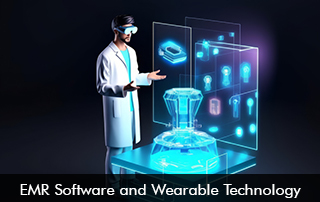Healthcare has been revolutionized with the seamless integration between Electronic Medical Records (EMR) Software and wearable technology. This gives clinicians real-time access to patient information like heartbeat, pulse, and BP to monitor patients remotely and intervene when needed. Almost 33% of US adults use wearable devices to track their fitness levels or daily health indicators. Wearables are getting more popular as they provide real-time tracking and encourage patients to a healthy lifestyle. For example, smartwatches can prompt an individual to move if they have rested for longer.
The Integration of EHR Software Systems with Wearable Technology
A major development in healthcare is the combination of wearable technology and Electronic Health Records (EHR) software, which creates a more connected and data-rich environment for patients and doctors.
Fitness trackers, smartwatches, and medical-grade monitors are examples of wearable technology that continuously gathers real-time data on a range of health variables, including heart rate, activity level, sleep patterns, and blood glucose levels.
This data is automatically synced and stored in the patient’s digital health record when coupled with EMR software. This gives medical personnel a thorough understanding of the patient’s condition. The constant flow of information enables proactive management of chronic illnesses, individualized treatment strategies, and faster and more accurate diagnosis.
Improved Patient Engagement with EHR Software and Wearable Technology
Patient empowerment and engagement are increased by the smooth information exchange between wearable technology and EMR Systems. In real-time, patients can track their health indicators and get alerts or feedback when their measurements deviate from normal. Patients are encouraged to actively manage their health with the instant feedback loop, which improves adherence to treatment regimens and promotes healthier lifestyle choices. Patients don’t have to visit their healthcare provider but manage their conditions from the comfort of their homes. Engaged patients are driven to make positive lifestyle changes such as exercising and switching to a healthier diet, etc.
Advantages of Integration between EMR Software and Wearables
There are many benefits for both patients and physicians when the robust technology of electronic medical records software integrates with wearables:
- Integration reduces manual data entry
- The data available from wearable technology can be used for population health management
- Digital records are automatically updated
- Accurate and timely diagnosis
- A boost in patient participation throughout their healthcare journey
- Better patient awareness about their conditions
- Saves hospitals with time and money
Challenges of Electronic Health Record Software and Wearable Technology
The integration of EMR software and wearable technology poses issues that must be addressed. Data security and privacy are top priorities, as the continual interchange of sensitive health information heightens the danger of cyber-attacks. Ensuring that data is encrypted and securely sent is critical.
Furthermore, data standardization is a challenge because wearables from different manufacturers may collect and transmit data in different forms and protocols. Interoperability standards are required to ensure that EHR software systems can correctly understand and use data from a variety of devices. Despite these obstacles, integrating EMR software with wearable technology has the potential to improve healthcare delivery by making it more proactive, personalized, and efficient.







